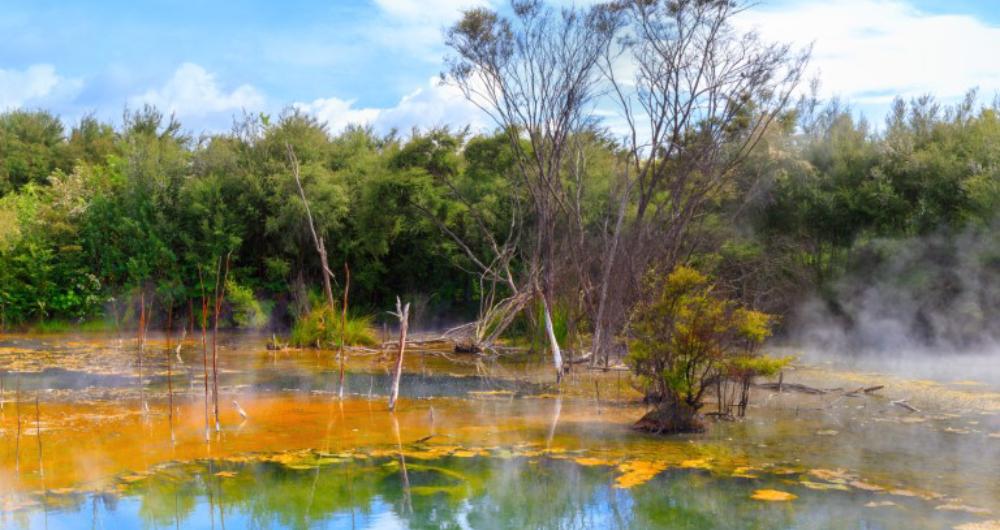In This Article
Craving geysers, Maori culture, and geothermal wonders? Discover Rotorua, New Zealand! Located in the heart of the North Island, Rotorua offers bubbling mud pools, natural hot springs, and deep cultural experiences. Whether you're soaking in a thermal spa, biking through redwood forests, or watching a haka, Rotorua is a place where nature and tradition collide beautifully.
Best Time to Visit
The best time to visit Rotorua is during spring and autumn (September–November and March–May) when the weather is mild and perfect for outdoor activities. Summer brings warm temperatures and festivals, while winter is quieter with crisp days and relaxing hot pool experiences.
How to Get There
- By Air: Rotorua Regional Airport (ROT) has direct flights from Auckland, Wellington, and Christchurch. It's about 15 minutes from the city centre.
- By Car: Rotorua is about 3 hours from Auckland or 1 hour from Taupo via scenic highways.
- By Bus: InterCity buses connect Rotorua with major North Island cities and towns.
Where to Stay
- Regent of Rotorua – Chic boutique hotel with a pool, spa, and fine dining near the lakefront.
- Holiday Inn Rotorua – Family-friendly with geothermal spa pools and easy access to Whakarewarewa Village.
- Rotorua Thermal Holiday Park – Budget-friendly cabins and campsites with access to natural hot mineral pools.
Top Attractions
1. Wander Through Earth’s Power in Motion at Waimangu Volcanic Valley
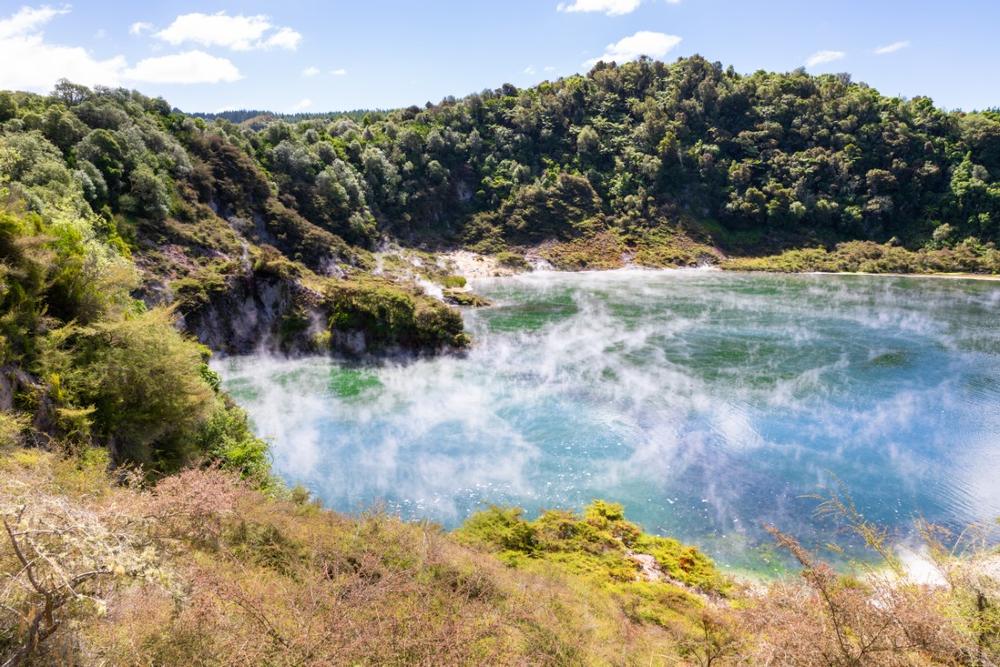
© magann/stock.adobe.com
TheWaimangu Volcanic Valley is a protected, hydrothermal system on the North Island of New Zealand that is home to the world's largest hot spring in lush natural surroundings. Formed in 1886 by the volcanic eruption of Mount Tarawera, the Waimangu Volcanic Rift Valley was so named for the black water that was thrown up by the Waimangu Geyser (Waimangu means black water in the Maori-language). The valley features several natural attractions, including Lake Rotomahana, the Waimangu Geyser, Frying Pan Lake, the largest hot spring in the world, and the steaming and spectacularly pale blue Inferno Crater Lake. The world’s youngest geothermal valley is home to a rare ecosystem that is packed with a diverse variety of fauna and flora and can be explored on a range of guided tours.
587 Waimangu Road, Rotorua 3043, New Zealand, Phone: +64-73-66-61-37
2. Marvel at Bubbling Beauty in Wai-O-Tapu Geothermal Wonderland
Explore colorful hot springs, craters, and the famous Champagne Pool.
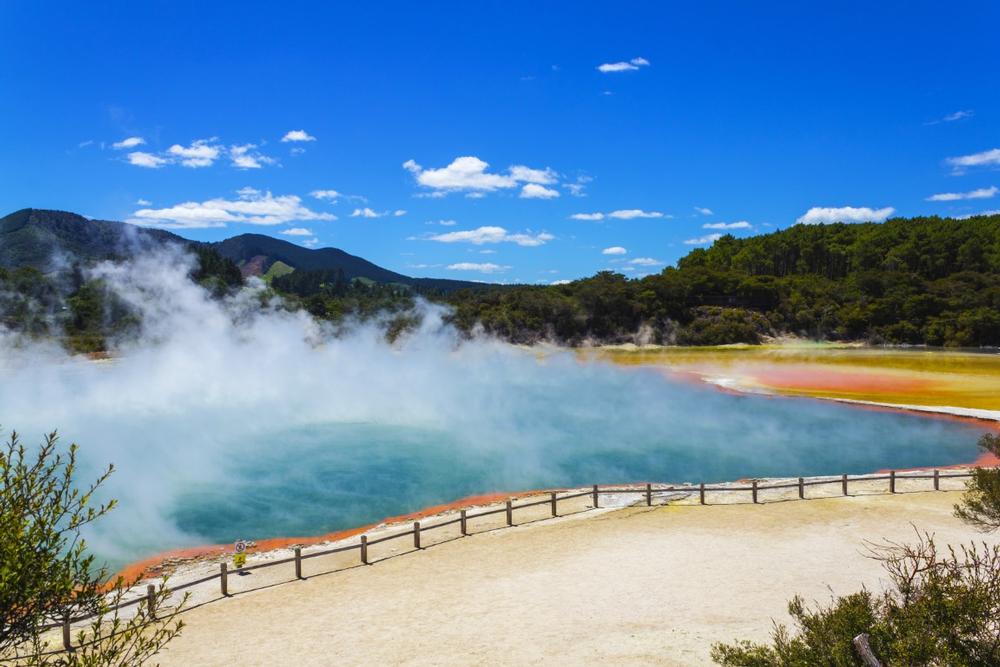
© Sorang/stock.adobe.com
Wai-O-Tapu, also spelled Waiotapu, is an active geothermal area in New Zealand's Taupo Volcanic Zone. Situated just north of the Reporoa caldera at the southern end of the Okataina Volcanic Centre, the whimsically named Wai-O-Tapu Thermal Wonderland is a series of brightly colored geothermal pools, explosive geysers, and smelly sulfur mud baths. The otherworldly geothermal park is a must-see attraction and sees visitors flocking to the park to experience the natural phenomena along with the active Lady Knox Geyser, the Devil’s Bathtub, and the Champagne Pool. A modern visitor’s center offers a wealth of information on the park, as well as well-signed pathways for visitors to follow at their own pace.
Wai-O-Tapu Geothermal Wonderland, 201 Waiotapu Loop Road, Rotorua 3073, New Zealand, Phone: +64-73-66-63-33
3. Experience Culture Alive at Whakarewarewa, The Living Maori Village
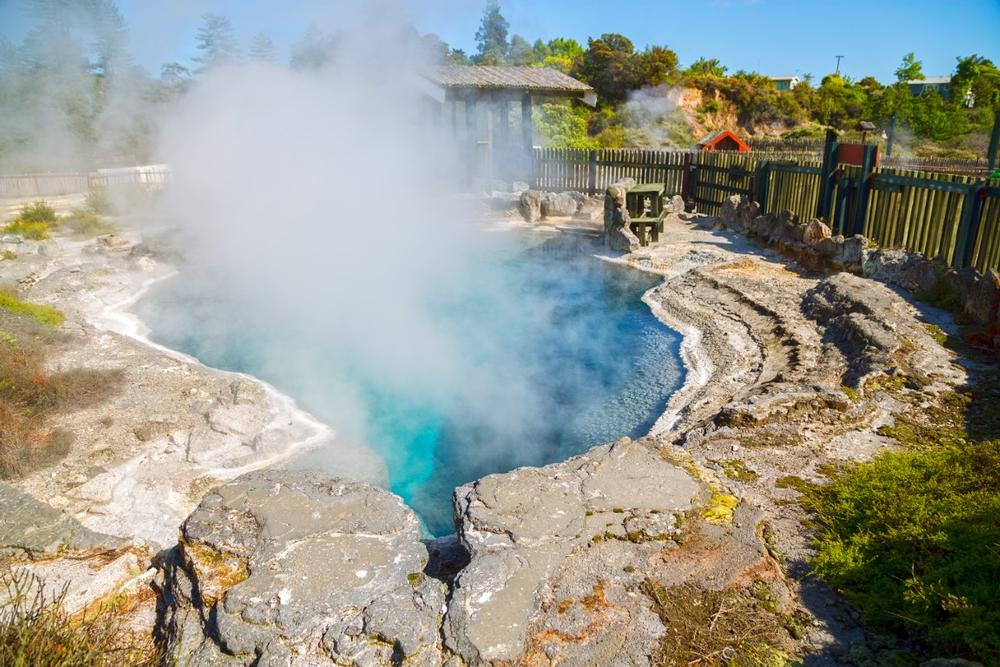
© Anupam/stock.adobe.com
Whakarewarewa, The Living Maori Village is the home of the local Tuhourangi Ngati Wahiao people and offers visitors the opportunity to experience their traditional and unique way of life. The popular cultural attraction has been attracting visitors for over 200 years with a variety of Maori dance performances and a traditional cultural feast. Surrounded by the spectacular beauty of the natural geothermal landscape of the valley, the Living Whakarewarewa Maori Village was established to preserve and honor the rich and diverse culture and heritage of the Tuhourangi Ngati Wahiao people.
17 Tryon Street, Whakarewarewa, Rotorua 3010, New Zealand, Phone: +64-73-49-34-63
4. Paddle, Picnic, or Reflect by the Shores of Lake Rotorua
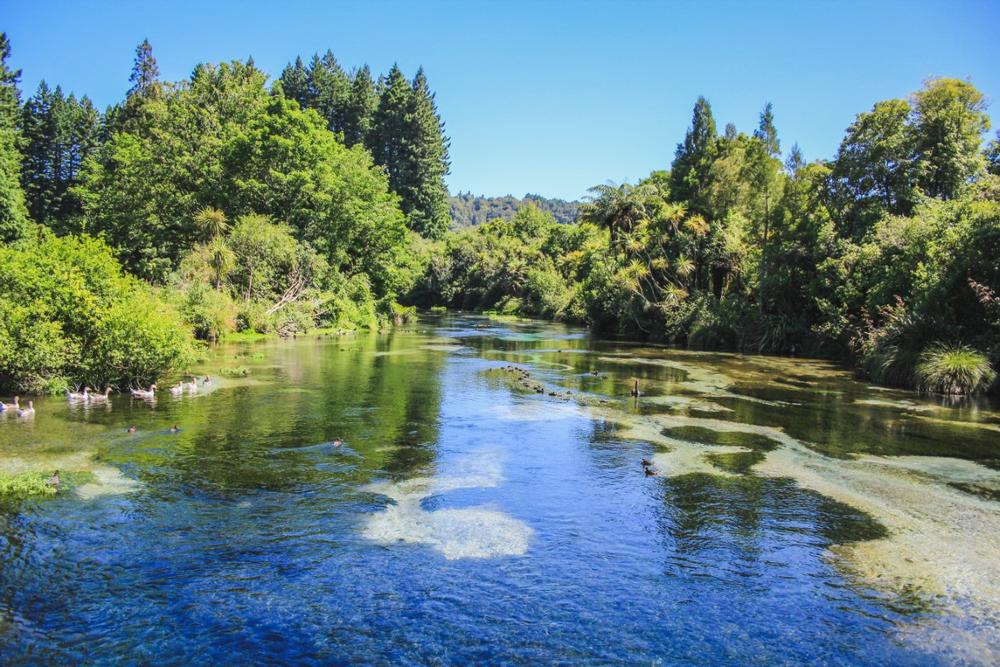
© Joppi/stock.adobe.com
Lake Rotorua is a 49-mile, 10-meter deep lake in the Bay of Plenty region and the second largest lake on the North Island. Named Rotorua-nui-a-Kahumatamomoe (aka ‘the large lake of Kahumatamomoe’), the now tranquil lake has a violent history with massive volcanic eruptions around 200,000 years ago and continuing geothermal activity in and around the lake today. The high sulfur content of the water results in a magical green-blue coloration and is the setting for the famous love story of Hinemoa and Tutanekai. The island of Mokoia sits in the center of the lake and is a sanctuary to endangered birds and wildlife.
Rotorua District, Bay of Plenty Region, North Island
5. Discover Mystical Mokoia Island and Its Maori Legends
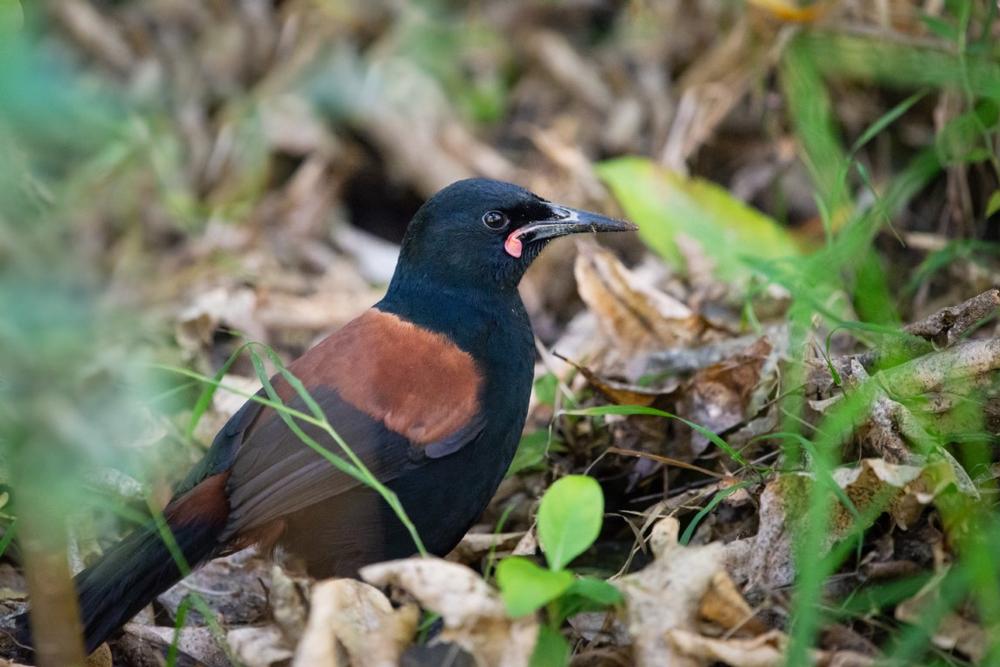
© Janice/stock.adobe.com
Mokoia Island is an island that lies in the middle of Lake Rotorua and is a sanctuary to endangered birds and wildlife. The 1.35-square-kilometer uninhabited island rises to 180 meters above the lake surface and is a rhyolite lava dome that was formed over 200,000 years ago and rhyolitic magma was pushed through the crack. The island is a protected home for many of New Zealand’s endangered wildlife and rare birds and is a popular gathering spot for private functions, weddings, team-building exercises, and school field trips.
Rotorua District, Bay of Plenty Region, North Island
6. Spot Rare Birds and Thermal Wonders at Sulfur Bay Wildlife Refuge
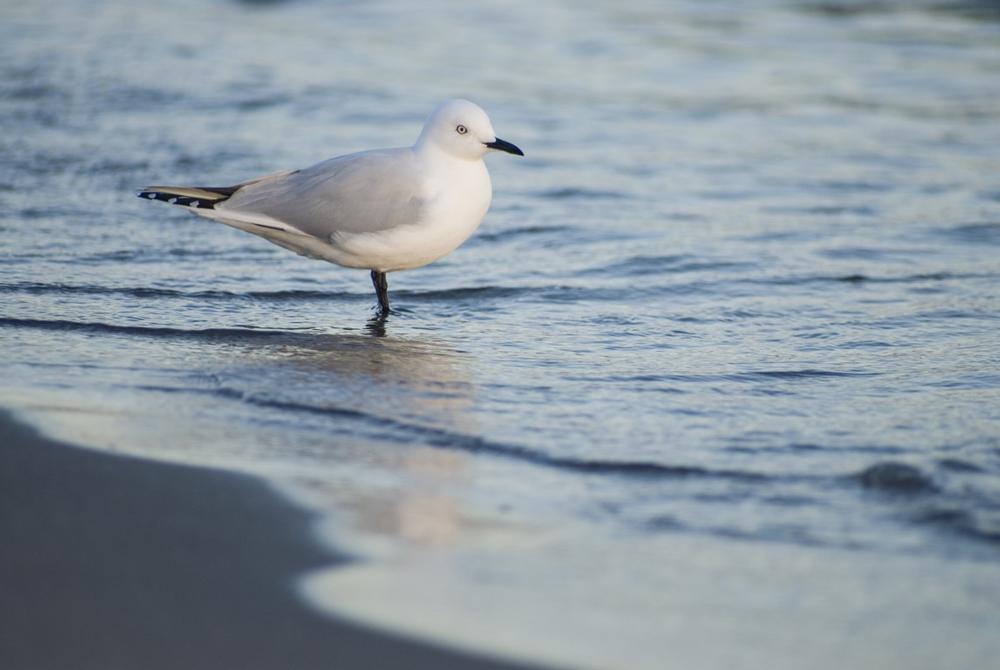
© Sebastian/stock.adobe.com
The Sulfur Bay Wildlife Refuge is a 145-hectare section of water in the south-eastern corner of Lake Rotorua known as Sulphur Bay and comprises a wildlife refuge and sanctuary that is home to a wealth of local and rare bird species including the nationally threatened New Zealand dabchicks, black-billed gulls, and banded dotterels. The Purenga stream flows into the bay, which stretches from Motutara Point to Ngapuna and creates geothermal features such as natural hot water and steam and boiling mud pools. It also makes the water appear murky due to sulfur suspensions and causes high acidity, sometimes damaging the feet of the birds.
Bay of Plenty, Rotorua
7. Stroll Through Rotorua’s Elegant Past in the Government Gardens
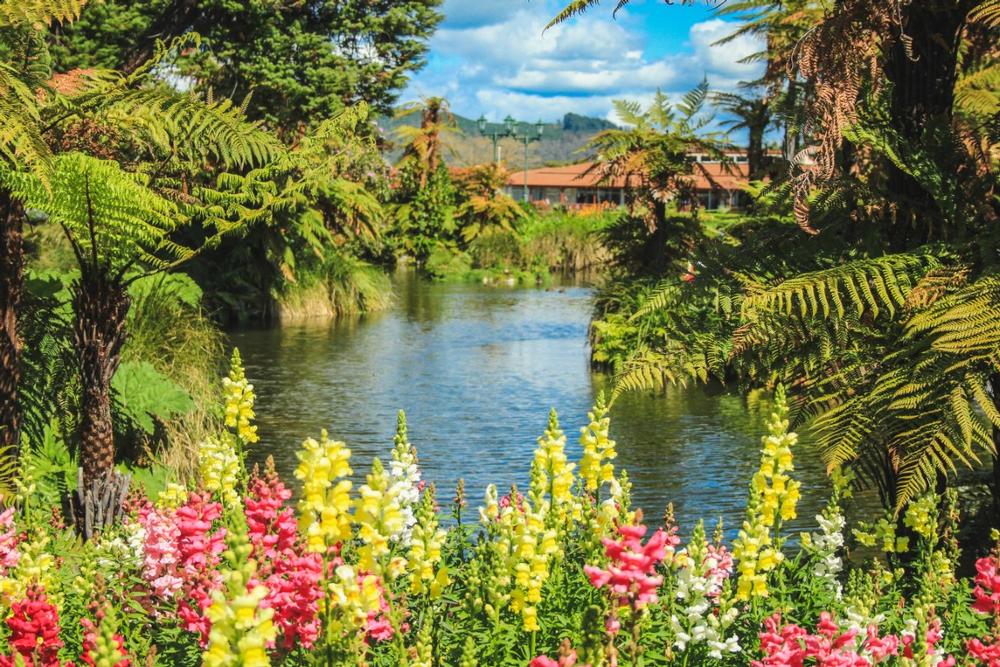
© Joppi/stock.adobe.com
The Government Gardens is a public park on the shores of Lake Rotorua in downtown Rotorua. Built by the government as a tourist attraction and partly laid out as beautifully manicured gardens, the historic gardens surround a Tudor-style spa bathhouse and a gorgeous Mediterranean-style public swimming pool and are one of New Zealand’s top tourist attractions. Known initially as Paepaekumana, the Government Gardens were the site where many significant battles took place in the late 1800s and are a historically essential and legendary site to local Maori people. The Elizabethan Tudor-style bathhouses a world-class museum and an award-winning exhibition on baths and the geothermal pools that feed them.
9 Queens Drive, Rotorua 3010, New Zealand
8. Walk Among Giants on the Elevated Redwoods Treewalk
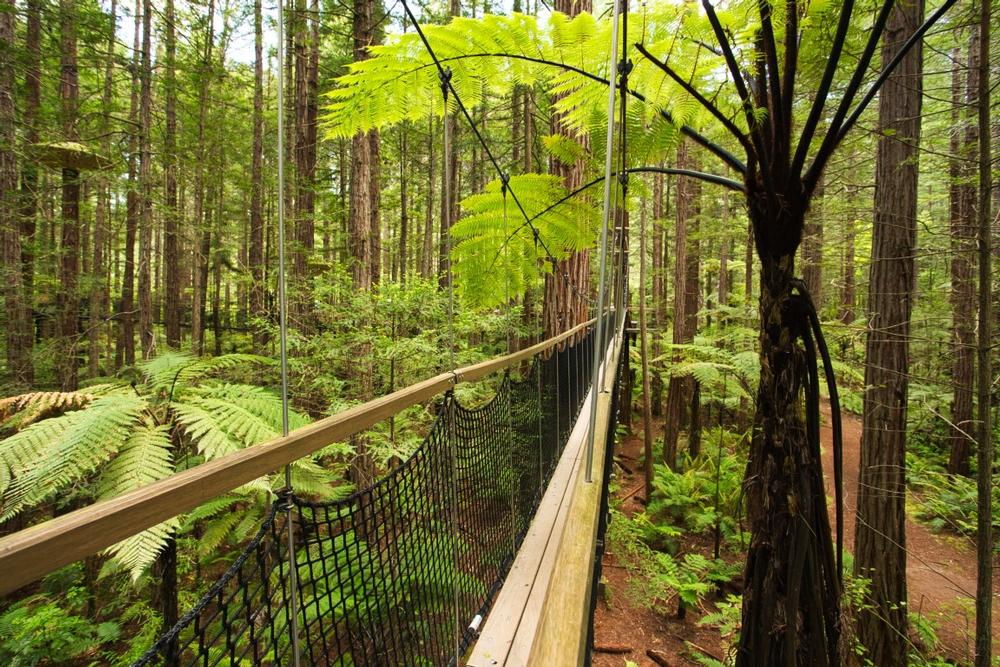
© romanslavik.com/stock.adobe.com
The Redwoods Treewalk is a popular recreational walk through the magnificent 115-year-old Redwood Forest. Located a short drive from downtown Rotorua, the 700-meter-long ecological walk is an award-winning tourist attraction that rests 20 meters above the forest floor and features 28 suspension bridges connecting 27 ancient Redwood trees, offering visitors the opportunity to see and experience nature at its best. The walkway features a uniquely constructed New Zealand-first technologically designed sling suspended from the Redwood trees that was specifically designed and built to preserve the trees, plants, and the surrounding natural environment. Informative storyboards along the walk educate visitors about the local fauna and flora.
Long Mile Road, Whakarewarewa, Rotorua 3010, New Zealand, Phone: +64-2-75-36-10-10
9. Plunge Into Pure Adrenaline - White Water Raft the Kaituna River
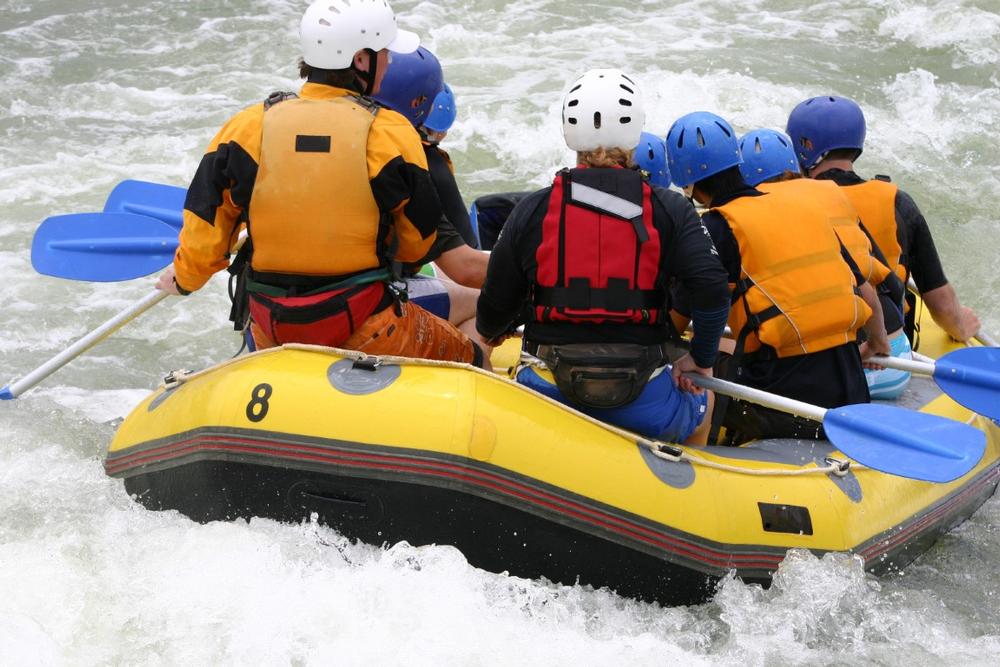
© Leah-Anne Thompson/stock.adobe.com
Established in 2011 to provide the best white water rafting in New Zealand, Rotorua Rafting offers spectacular white-water rafting adventures on the world-famous Kaituna River. Home to several magnificent waterfalls, including Okere Falls, Kaituna Falls, and the world-renowned Tutea Falls, which is the highest commercially rafted waterfall in the world, the Kaituna River is a short drive from Rotorua and promises an adrenaline-rushing experience. Rafting trips are guided by certified river instructors with internationally recognized qualifications and cater to all skill levels of paddlers. All safety equipment is provided.
White Water Rafting at the Kaituna River, 761 State Highway 33, Okere Falls 3074, New Zealand
10. If You Crave Scenic Cycling, Ride Te Ara Ahi - The Thermal by Bike Trail
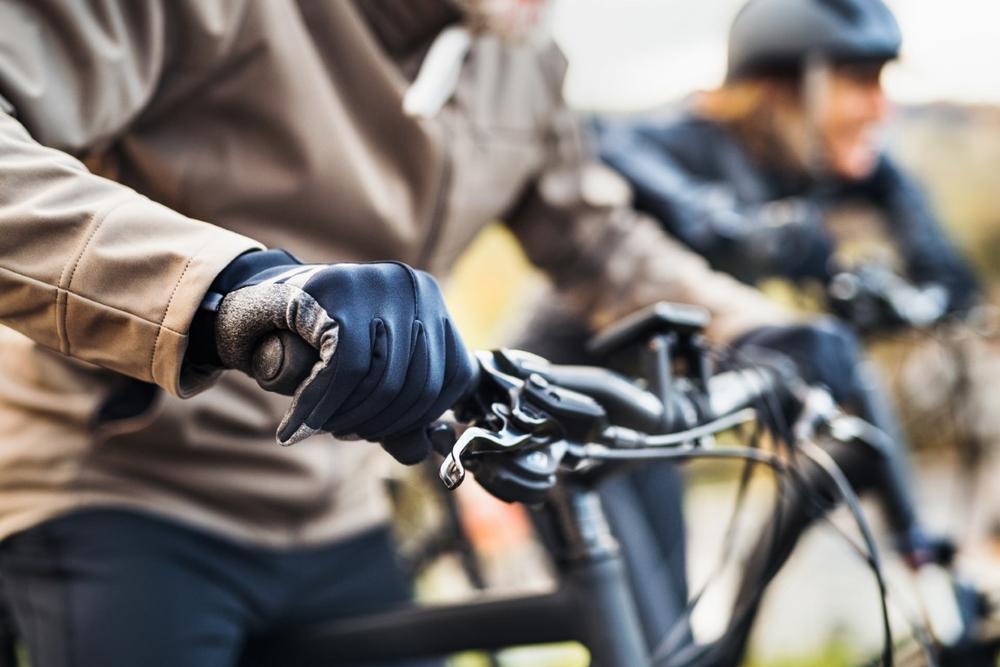
© Halfpoint/stock.adobe.com
Te Ara Ahi - The Thermal by Bike Trail is a guided bike trail that visits ancient Maori cultural sites, hot springs and geothermal wonderlands, along with other must-see attractions. Dubbed Thermal by Bike, the bike ride begins near Rotorua’s lakefront and comprises three continuous sections ranging from easy to intermediate, passing four geothermal areas, historical Maori cultural sites, beautiful lake and mountain views, and plenty of cafés for water breaks. Adventurers can also take a detour and explore Rotorua’s world-famous Redwoods Mountain Bike Park.
Where to Eat
- Atticus Finch – Contemporary NZ dishes and share plates served in a stylish lakefront setting.
- Capers Café + Store – Brunch hotspot with artisan pastries, local products, and hearty Kiwi fare.
- Stratosfare Restaurant – Buffet dining with epic views at the top of the Skyline Rotorua gondola.
Local Events
- Rotorua Night Market (Thursdays) – Enjoy street food, local crafts, and live music in the city centre.
- Matariki Celebrations (June/July) – Maori New Year events with storytelling, art, and astronomy.
- Crankworx Rotorua (March) – International mountain biking festival with thrilling races and stunt shows.
Day Trips Within 30 Minutes of Rotorua, New Zealand
- Ngongotaha (10–15 min) – Ride the Skyline gondola, visit the wildlife park, or fish Lake Rotorua’s edge.
- Lake Okareka (15–20 min) – Hike the boardwalk trail, kayak peaceful waters, or relax at secluded lake beaches.
- Hamurana (15–20 min) – Walk the redwood grove, visit crystal-clear springs, or enjoy quiet lakefront views.
- Tikitere (15–20 min) – Explore Hell’s Gate geothermal park, soak in a mud spa, or learn about local Maori legends.
- Lake Tarawera (North End) (25–30 min) – Hike to hidden hot springs, enjoy boating and fishing, or soak in scenic lakefront serenity.
- Rotoiti Forest Area (20–25 min) – Paddle to thermal pools, mountain bike forest trails, or discover geothermal hideaways.
- Owhata (10–15 min) – Visit local marae, enjoy nearby geothermal walks, or stop at casual eateries along the way.
- Whakarewarewa (5–10 min) – Tour the living Maori village, witness bubbling mud pools, or explore geothermal walkways.
- Waikite Valley (25–30 min) – Soak in natural hot pools, explore steamy bush trails, or relax in a quiet geothermal setting.
FAQ
-
Where is Rotorua located?
- Nestled within the Pacific Rim of Fire on its namesake lake on New Zealand's North Island, Rotorua is renowned for its shooting geysers, bubbling mud pools, natural hot springs, and rich Maori culture.
-
What natural attractions can be found in Rotorua?
- The city offers a wealth of attractions, including soaking in thermal mud pools and watching the 30m-tall Pohutu Geyser erupt.
-
What outdoor activities are available in Rotorua?
- Adventurers can enjoy epic mountain biking, hiking through magical forests, and along crystal-clear streams.
-
How can visitors experience Maori culture in Rotorua?
- Visitors can also experience a living Maori village to learn more about the traditions of the local culture.
At a Glance
| Best Time to Visit |
Places to Stay |
Top Activities |
| Spring (September-November) – Mild temperatures, blooming gardens, and fewer crowds. |
Regent of Rotorua Boutique Hotel – A stylish and modern stay in the city center. |
Visit Government Gardens – Enjoy colorful flower displays and historic architecture. |
| Summer (December-February) – Warm and ideal for outdoor adventures. |
Solitaire Lodge – A luxury lakeside retreat with breathtaking views. |
Explore Wai-O-Tapu Thermal Wonderland – See geothermal wonders like the Champagne Pool. |
| Fall (March-May) – Pleasant weather and fewer tourists. |
Pullman Rotorua – A comfortable and centrally located hotel. |
Experience a Maori cultural evening at Tamaki Maori Village – Enjoy performances and a traditional hangi feast. |
| Winter (June-August) – Cool temperatures, perfect for hot springs and spa retreats. |
VR Rotorua Lake Resort – A cozy lakeside getaway. |
Relax at the Polynesian Spa – Soak in natural geothermal mineral pools. |
How did I do?
Is the article too broad, too narrow, or just right ? Do you like the presentation of photos and text? Let me know in the comments! If you want to see more in this location, I can put it on my editorial calendar. I'm listening!
Plan Your Trip


